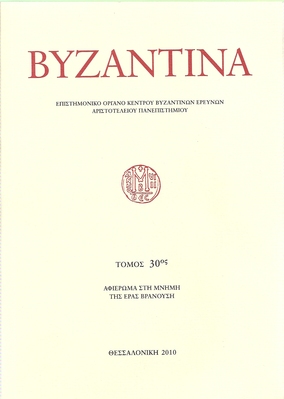Constantino Rodio e la dieresi mediana : Anth. Pal. XV 15
Part of : Βυζαντινά : επιστημονικόν όργανον Κέντρου Βυζαντινών Ερευνών Φιλοσοφικής Σχολής Αριστοτελείου Πανεπιστημίου ; Vol.31, No.1, 2011, pages 9-32
Issue:
Pages:
9-32
Parallel Title:
Constantine the Rhodian and the medial diaeresis : Anth.Pal. XV 15
Author:
Abstract:
Constantine the Rhodian is one of the most important Byzantine poets of the Xth century. He left us a famous ekphrasis of the Constantinopolitan church of the Holy Apostles, as well as some dodecasyllabic or hexametric epigrams. In one of these, Anth. Pal. XV 15, Constantine celebrates the dedication of a cross at the native city Lindos, in the Rhodes isle. The epigram must be dated between the reigns of Leo VI, Alexander and Constantine VII Porphyrogenitus, these last two being respectively the brother and the son of the first emperor. Both the datation and the translation of the epigram is not shared by all the scholars; particularly line 5, where we read yet the text established by the early editors of the Anthologia Palatina, seems to be problematic as concerns the metre and the translation. However, by analyzing some not considered aspects till now (such as the lections of the codex, to be preserved even for the metre because of the Byzantine rules of the hexameter, or the correct interpretation of the lemma attached to the epigram), this paper demonstrates both that Constantine the Rhodian can’t be the same person of the so-called scribe J of the Palatine codex and that line 5 of the epigram, as transmitted in the codex, is quite correct as regards the Byzantine hexametric rules and must be preserved.
Subject:
Subject (LC):
Notes:
Περιέχει 2 εικόνες, La bibliografia citata più duna volta nelle note a piè di pagina è abbreviata secondo le sigle e i compendi di volta in volta indicati. Per questo studio si è usufruito di un finanziamento erogato dall’Università di Salerno per un progetto FARB (ex 60%) sulla poesia epigrammatica bizantina. Mi sia consentito un vivo ringraziamento a Christian Forstel (Conservateur chargé des manuscrits grecs, Bibliothèque nationale de France, Paris), che con la sua consueta liberalità ha voluto inviarmi dettagliate foto digitali ad alta risoluzione del Paris. Suppl, gr. 384, le quali hanno consentito una migliore lettura del codice rispetto alle riproduzioni da microfilm in mio possesso. Ringrazio altresì gli amici e i colleghi che hanno contribuito con le loro osservazioni a migliorare in più punti rimpianto di questo lavoro.




